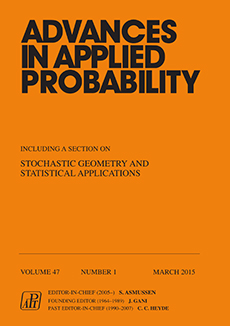Abstract
In the full rectangular version of Gilbert's planar tessellation (see Gilbert (1967), Mackisack and Miles (1996), and Burridge et al. (2013)), lines extend either horizontally (with east- and west-growing rays) or vertically (north- and south-growing rays) from seed points which form a stationary Poisson point process, each ray stopping when it meets another ray that has blocked its path. In the half-Gilbert rectangular version, east- and south-growing rays, whilst having the potential to block each other, do not interact with west and north rays, and vice versa. East- and south-growing rays have a reciprocality of blocking, as do west and north. In this paper we significantly expand and simplify the half-Gilbert analytic results that we gave in Burridge et al. (2013). We also show how the idea of reciprocality of blocking between rays can be used in a much wider context, with rays not necessarily orthogonal and with seeds that produce more than two rays.
Citation
James Burridge. Richard Cowan. "Planar tessellations that have the half-Gilbert structure." Adv. in Appl. Probab. 48 (2) 574 - 584, June 2016.
Information





